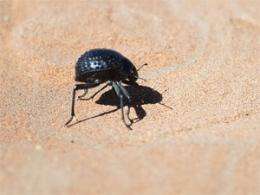November 25, 2012 weblog
Self-filling water bottle takes cues from desert beetle

(Phys.org)—Biomimicry is the term given to using nature as an inspiration for sustainable technology ideas, and a young company has joined the biomimicry brigade with its prototype self filling water bottle, which mimics the Namib desert beetle. NBD Nano, a startup of four graduates with degrees in biology, organic chemistry, and mechanical engineering, hopes to bring their prototype to market. They say that, like this beetle, their bottle can pull water from the air. Their self-filling water bottle is said to be capable of storing up to three liters every hour.
The desert beetle in focus can live in an area which gets only 0.5" of rainfall a year. Its shell is covered in bumps, and the way the bumps are constructed are key to its survival. Humidity in the air accumulates on the shell until water droplets form. They roll down the beetle's back and directly into its mouth. The NBD Nano team drew from the natural shell design in constructing a bottle that could take advantage of the same water-collecting process. The result is that the bottle is able to continually fill itself up. They describe their process as making use of a nano-scale surface to enhance water condensation. The surface of the bottle is covered with hydrophilic (water-attracting) and hydrophobic (water-repellent) materials.
They would not be the first to study the Namib beetle's modus operandi for surviving in harshly arid conditions. National Geographic in 2001 said scientists were studying the beetle, noting how the beetle can survive via its bumpy shell drawing its drinking water from winds. Zoologist Andrew Parker of the University of Oxford detailed how it was an efficient water-harvester in capturing water from the wind. Parker, who reported his findings in Nature, suggested that the shell was a promising model for designing inexpensive tent coverings and roof tiles that could collect water for drinking and for agriculture in arid regions.
As for NBD Nano, they are only in prototype stage. "We have developed a proof of concept and [are] currently creating our first fully-functional prototype," Miguel Galvez, one of the co-founders, said.
How much water does the bottle harvest from air? Galvez told the BBC that "We think our initial prototype will collect anywhere from half a liter of water to three liters per hour, depending on local environments."
They have varied applications in mind. They list enhanced dehumidification for households; potable water for military operations; water for greenhouses to support plant life; and potable water for third world nations.
"We realize that water is such a large issue in the world today, and we want to try to alleviate those problems with a cost-efficient solution," said Deckard Sorensen, another company co-founder. Sorenson said the company is looking to incorporate the bottle in greenhouses or green roofs in the immediate future, but later on will be looking to see how far they can scale up to supply larger agricultural goals.
NBD Nano plans to enter the worldwide marketplace between 2014 and 2015.
More information: www.nbdnano.com/
Journal information: Nature
© 2012 Phys.org



















